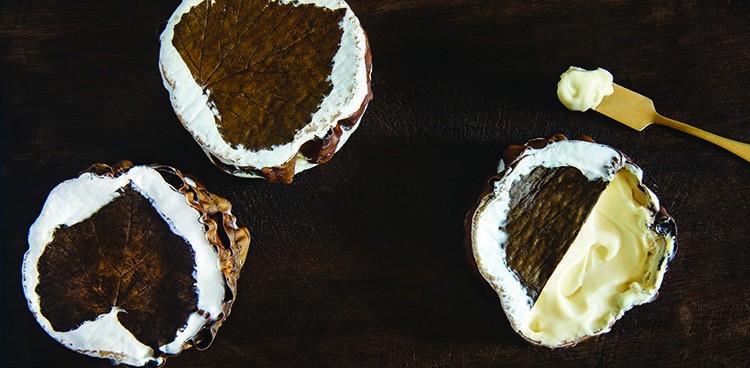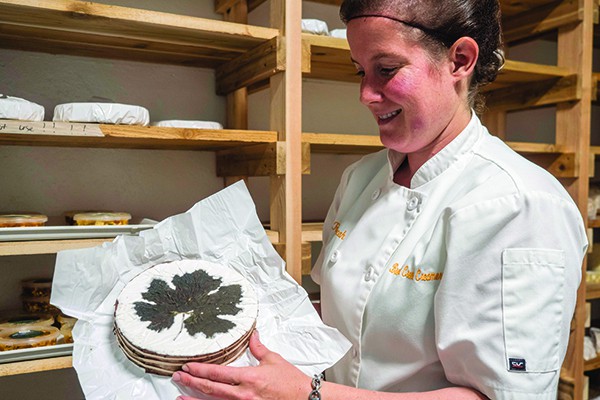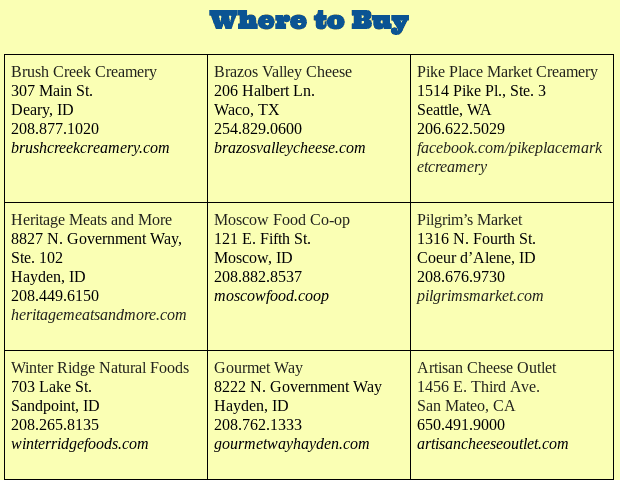
Rebeccah Salmeri was just a teenager when she crafted her first batches of cheese. Her brothers rigged up a makeshift press out of dowels, plywood, and an empty tin can. “It was pretty rugged,” Salmeri says. “We banged holes in the can for the whey to come out and used a disposable pie plate to catch the (liquid).” An old refrigerator in the shed became her aging cave. The mozzarella she made tasted like a giant rubber band, she says, but her family thought her pepper Jack was pretty darn good.
That same can-do spirit has fueled Salmeri’s fast rise in the cheesemaking world. Over the span of her decade-plus career, she founded Waco, Texas-based Brazos Valley Cheese, married and moved to northern Idaho with her husband, Brian Salmeri, and began building a second venture: Brush Creek Creamery.
In Salmeri’s biggest barn burner yet, Brush Creek’s Mountain Maple Brie was named best cow’s milk brie at the 2016 American Cheese Society Judging and Competition.
The wheel is gorgeous, seemingly gift-wrapped by forest nymphs, with Idahoan Mountain Maple bark curled around its circumference and boiled grape leaves arranged on top. Take a bite, and it reveals creamy tang of citrus and hard cider, notes of bacon and salt, and a smoky finish. Gooier and (dare we say) richer than French Brie, and with its unconventional packaging, Mountain Maple Brie is an American original, says cheese expert Margaret Peters Morris. The president of Ontario, Canada’s Glengarry Cheesemaking, Morris helped get Salmeri’s business off the ground and can speak to her ability to reimagine curd varieties: “What’s interesting is that it’s a special bloomy rind with that maple wrap. That’s very innovative,” she says. “It’s not like a Brie—it’s very American in its culture. We’re here on another continent…we have to make products that are identifiable to us.”
A Homestead Start
Initiative runs in Salmeri’s blood. Her parents, Kevin and Kelly Durkin, were living in New Jersey when Rebeccah was born. Kevin was training to be a surgical pathologist at Columbia University in New York City when he felt the tug to move west. The couple—and baby Rebeccah—went back to the land in the late 1970s, even though that movement was otherwise easing off.
The Durkins arrived in Colorado and promptly bought a goat, determined to figure out farming (although they had no idea even how to milk the thing). After a few years, they moved again, this time settling outside Waco, Texas, as part of Homestead Heritage, an intentional agrarian community, and Christian cooperative. Together, the 40 families there established a gristmill, an annual Sorghum Festival, and a craft village complete with a pottery house, blacksmith shop, woodworking shop, and fiber-crafts cottage.
Salmeri was a honeybee of a kid, helpful and industrious, always cooking, sewing, and gardening (and leading her six siblings in the farm’s many tasks).
“We were always pushing on every front we could, whether canning or raising or preserving food,” Kevin says. “Rebeccah has a lot of determination and leadership. My wife says she gets it from me, but she’s a real entrepreneur, and she grew up in a place where that was encouraged. She takes hold of things and runs with them.”
After her first cheesemaking attempt, Salmeri kept experimenting with dairy and even sold some wheels at Homestead Heritage’s annual Thanksgiving Fair. By the time her cousin Marc Kuehl visited the community in 2005, Salmeri had a vision to start a real-deal creamery—so Kuehl stayed to help build it. The two established Brazos Valley Cheese the next year. During this time, Rebeccah met Brian Salmeri, who’d recently returned to the Homestead community to start a 30-cow dairy after a decade away. She began buying milk from him for Brazos Valley Cheese, and within the year they were engaged.
That wasn’t the only auspicious meeting that came about during the Brazos years. When then Texas governor George W. Bush and his family bought a ranch not far from Homestead Heritage, Salmeri often cooked and cleaned house for them. After he became president, Bush served Brazos Valley’s marinated curds to visiting dignitaries. Salmeri even met Silvio Berlusconi, then prime minister of Italy, who told her, “I didn’t think you could get good cheese in America.”
The Trail to Brush Creek Creamery
Once Salmeri met the French cheesemaking consultant Ivan Larcher at the 2009 American Cheese Society conference, a fascination with brie-making was born. Larcher taught her how to drop the temperature during aging so the raw-milk product could age to a 60-day peak. Salmeri and her family played with brie’s flavor profile, trying chive and black pepper varieties. They took inspiration from cheeses like Jasper Hill Farm Winnimere, wrapped in spruce bark from northwoods Vermont. In Texas, Kevin Durkin thought, they should try mesquite, and found it lent the cheese a nutty flavor.
That brie was dubbed Brazos Select after being not only wrapped in mesquite but also painted with Homestead’s farm-made sorghum syrup. Next came Eden, a brie wrapped in fig leaves with a line of vegetable ash down the center. Both quickly won awards, and Salmeri was smitten. “Personally,” she says, “I love brie—that creamy smooth flavor and texture—and it pairs with just anything.”
A few weeks after their honeymoon, the Salmeris packed their cheesemaking supplies in a cargo trailer. They hooked it to their pickup, beckoned their Blue Heeler, Pepper, to the back seat, and drove three days to Idaho’s piney woods to run Brush Creek Creamery. Their good friends, Webb and Lisa French, started the business in 2010, after leaving Homestead Heritage to found a sister community in Deary, Idaho. The Frenches were milking three Jersey cows, making a few cheeses in a 36-gallon soup cauldron, and selling them at the farmers’ market. For Salmeri, it was like stepping back in time to the start of Brazos Valley. She got straight to work.
Five years later, the settlement in Deary is flourishing. The eight-family group recently worked together to establish a bakery-restaurant-creamery, the Pie Safe Bakery & Kitchen, in an old Ford showroom they gutted. When Salmeri buzzes in on a Tuesday morning, production is in full swing.
With her four-month-old baby, Jason, strapped to her chest, she peeks into the creamery to see Brian scooping curds for their Montasio, an airy, Italian monastery style infused with roasted garlic, parsley, and crushed red pepper. The place smells of the flavoring. On another side of the 7,000-square-foot space, cinnamon rolls are baking, but the two scents never blend—the areas are separated so the bakery’s yeasts so won’t affect the cheeses.
Customers seek out the Main Street spot from college outposts like Moscow and resort towns like Coeur d’Alene for its old-fashioned country feel: pressed-tin ceilings, racks of quilts and leatherwork, shelves of beeswax candles and homemade jams, and, of course, a cooler full of fresh dairy products. It’s all arranged around the car dealership’s old safe, deep in the building’s heart. The families converted the safe into a brick oven that serves the 100-seat dining room on weekends. The place has the old-timey feel of a Cracker Barrel, but with better food.
Mountain Maple Brie represents the crowning glory—thus far—of Salmeri’s cheesemaking efforts. Mountain Maple bark (a favorite snack for the moose, deer, and beavers that live along Idaho’s Potlatch River) lends the wheel its smoky notes. Grape leaves from nearby Colter’s Creek Winery infuse it with earthiness. Chefs in Seattle and beyond have raved about it, and at last year’s American Cheese Society Judging and Competition, judges did, too. Specifically, they went on and on about its texture: “Light but creamy, perfectly ripened, gorgeous, everything about it flowing and velvety, held together, not overly running.” Another wrote simply, “I’ve never eaten a brie like this in my whole life.” Among the 2016 class of cow’s milk bries, Mountain Maple Brie got a perfect score.
Today, Brush Creek Creamery is growing, recently purchasing a 200-gallon vat. The enterprising Salmeri would love to get Mountain Maple Brie to more outlets, especially beyond Texas and the West Coast, but she is also committed to small-batch production. “I can’t ever see producing it on a mass scale, because we cut it by hand, stir it by hand, harvest the bark and the leaves by hand,” she says. “It’s really a special cheese.”
Pairing Notes
One of Salmeri’s favorite matches for Mountain Maple Brie is a homemade conserve made with apple, red wine, walnuts, and honey (it complements the cheese’s grape-leaf wrapping and slight cider tang). Dollops of the silky, smoky paste are also excellent on a salad with bacon vinaigrette. Or, to finish a meal on a decadent-but-not-too-sweet note, try it alongside roasted pears drizzled with maple syrup.






